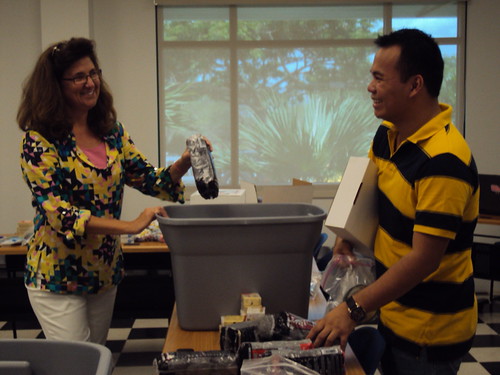![]()
Stacie Williams puts together a science kit
It’s no jape, there are fewer female scientists than male ones. In fact, the National Science Foundation says biases against female students in the science classrooms persist, as do myths like “girls are less interested in science than boys are.” The Women in Technology Project (WIT), founded by the Maui Economic Development Board (MEDB) in 2000, has honed in on this issue. They’re now training Maui County educators in a three-day professional development course entitled “Science Building Blocks,” in a partnership with the Air Force Research Laboratory and University of Hawaii Maui College. The course offers teachers science, technology, engineering and math (STEM) training.
“We know that girls start to make gendered career assumptions as early as age seven, so by supporting our teachers with the tools to teach science and math concepts in exciting and interesting ways, we know we are debunking the stereotypes that these subjects are boring and only for geeks,” says Leslie Wilkins, Program Director of Women in Technology. “WIT includes gender equity principles in all its trainings and will provide female science role models in follow-up support for the teachers.”
Stacie Williams is the Program Director of Community Outreach for the Air Force Research Laboratory (AFRL). She’s determined to even up the numbers by motivating young girls, as well as boys, toward science even before they’re out of grade school.
When Williams was in college, she she says she was the only woman in her physics class. “That was pretty typical in my advanced science courses,” she says. “By developing STEM programs for 3rd, 4th and 5th graders as part of AFRL’s outreach efforts, we’re working toward engaging Maui kids as early as possible.”
Williams spent months working with Dr. Sally Irwin, Associate Professor of Microbiology and Genetics at the UH Maui College, on reinterpreting scientific principles for a younger audience so that the learning material was interesting and understandable, while still meeting Hawaii’s Common Core Standards.
They held their first course at Maui Economic Development Board’s Malcolm Center July 19-21. Eighteen elementary school teachers, including three from Molokai, signed up for the hands-on biology and physical science course. Each participant received a complete science kit and curriculum to use in the workshop as well as later in the classroom. In addition, each teacher earned a $300 stipend.
“When I think of the old method I think of passive learning which doesn’t engage all students and focuses mainly on lectures to teach content,” Irwin says. “However, I think that the education community has made a lot of progress incorporating inquiry and student problem solving into science education. It is essential that we begin by changing teachers’ attitudes about science. When a teacher is excited and motivated, it gets passed down to the students.
Irwin taught fermentation, cell biology and genetics. One of the activities she did with the teachers was Rebops: the teachers had to create a “child” using marshmallows, toothpicks, thumb tacks that resembled the “parents” that Sally made. It’s a simple activity that they could share with their students to help understand genetics.
“The teachers really appreciated the well-structured lessons on light, optics, sound, circuitry, as well as biology,” MEDB Project Manager Mapu Quitazol says. “But what really pulled it together for them were the fun hands-on activities. They can’t wait for school to begin to try them out with their students!”
[miniflickr photoset_id=72157627273020191&sortby=date-posted-asc&per_page=50]
